Analysis of Motivation and Perception in Kellogg's Business Operations
VerifiedAdded on 2020/10/22
|8
|1353
|167
Report
AI Summary
This report examines the motivation and perception strategies employed by Kellogg's, a multinational food manufacturing company. It explores how Kellogg's utilizes motivational theories, such as the Scientific Management concept and Maslow's hierarchy of needs, to enhance employee performance and achieve organizational goals. The report delves into the practical application of these theories, including the use of monetary rewards, flexible benefit programs, and the fulfillment of various employee needs (physiological, safety, social, self-actualization, and love/belongingness) to foster a motivated workforce. The analysis highlights how Kellogg's creates a positive work environment and provides opportunities for employees to thrive, ultimately contributing to the company's success in the competitive global market. The report concludes by emphasizing the importance of these strategies in achieving organizational objectives effectively.
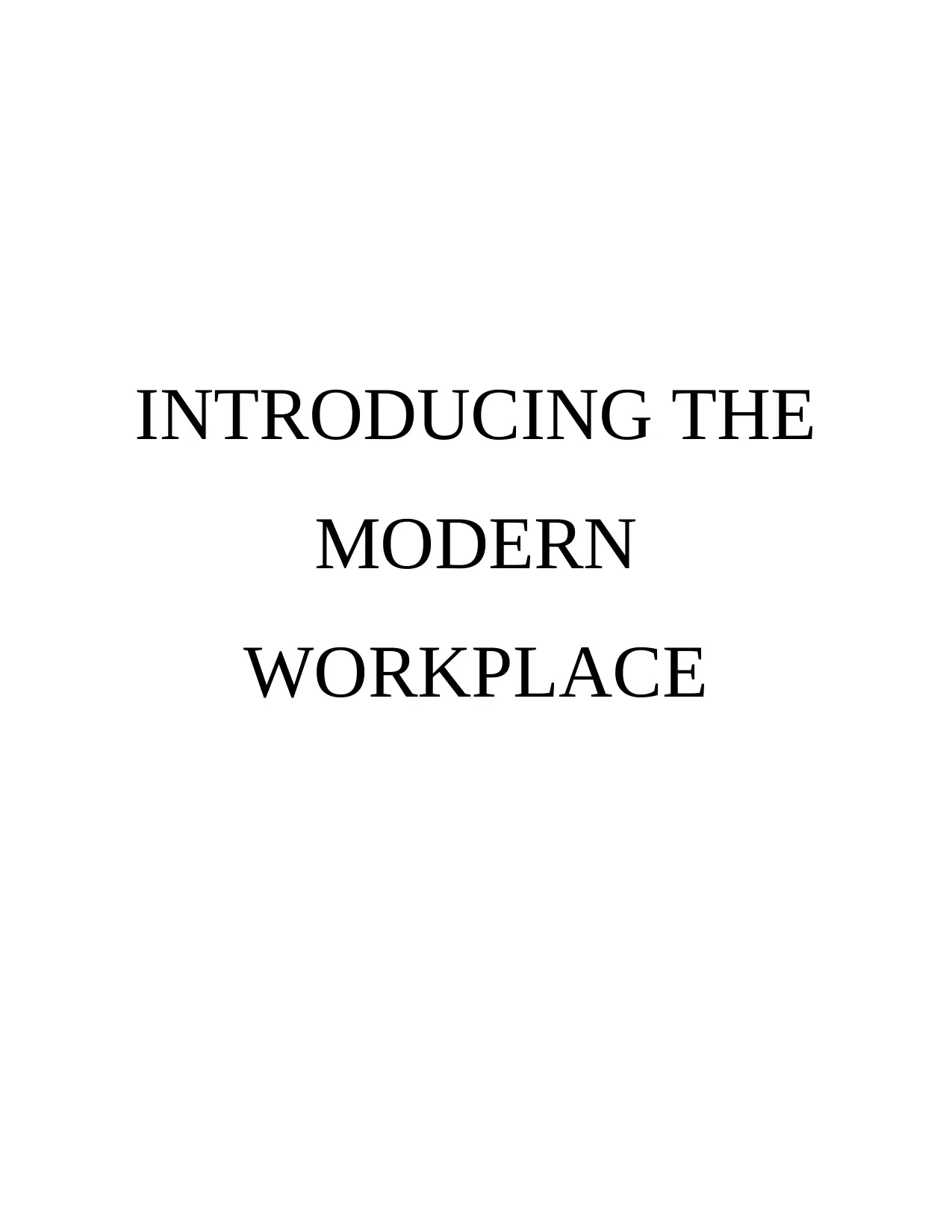
INTRODUCING THE
MODERN
WORKPLACE
MODERN
WORKPLACE
Paraphrase This Document
Need a fresh take? Get an instant paraphrase of this document with our AI Paraphraser
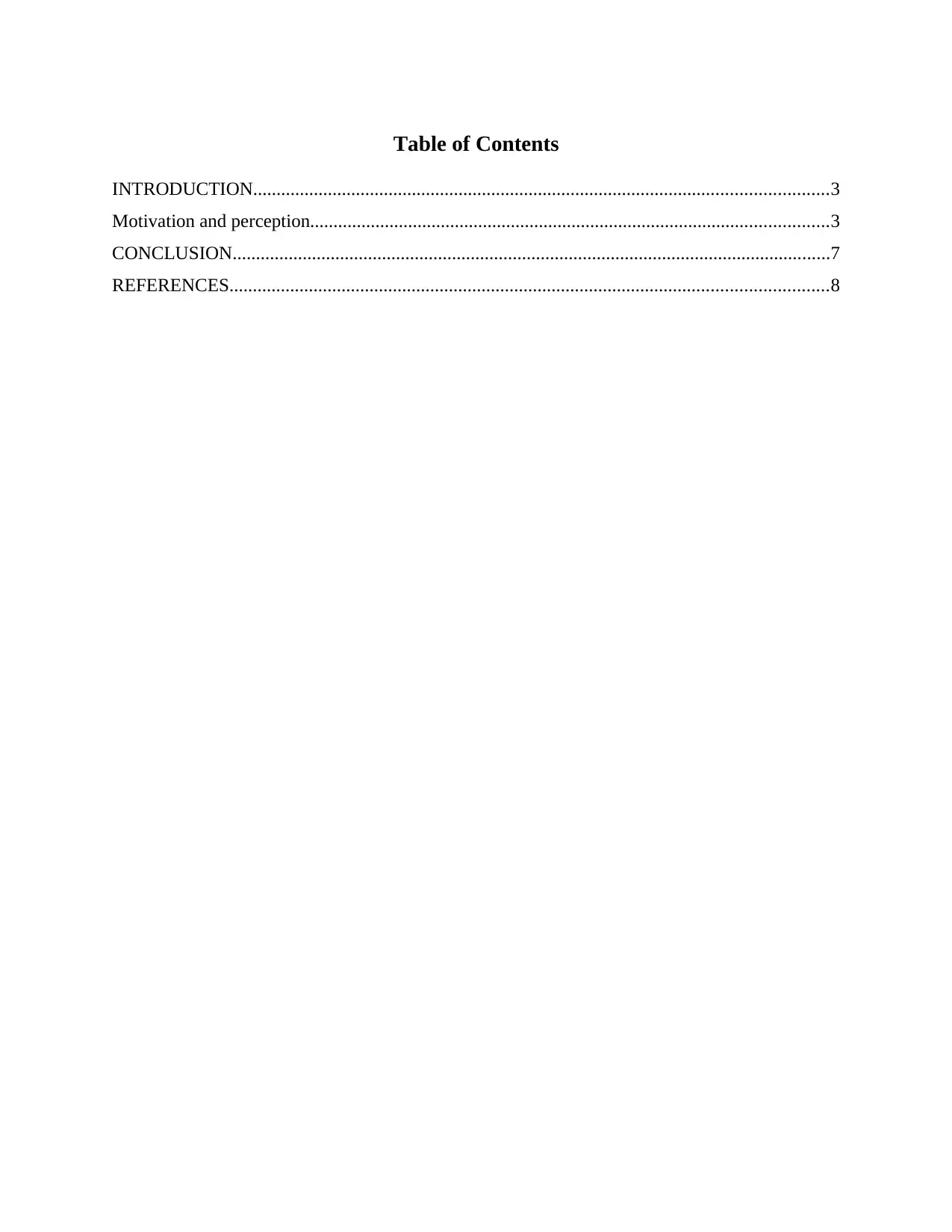
Table of Contents
INTRODUCTION...........................................................................................................................3
Motivation and perception...............................................................................................................3
CONCLUSION................................................................................................................................7
REFERENCES................................................................................................................................8
INTRODUCTION...........................................................................................................................3
Motivation and perception...............................................................................................................3
CONCLUSION................................................................................................................................7
REFERENCES................................................................................................................................8
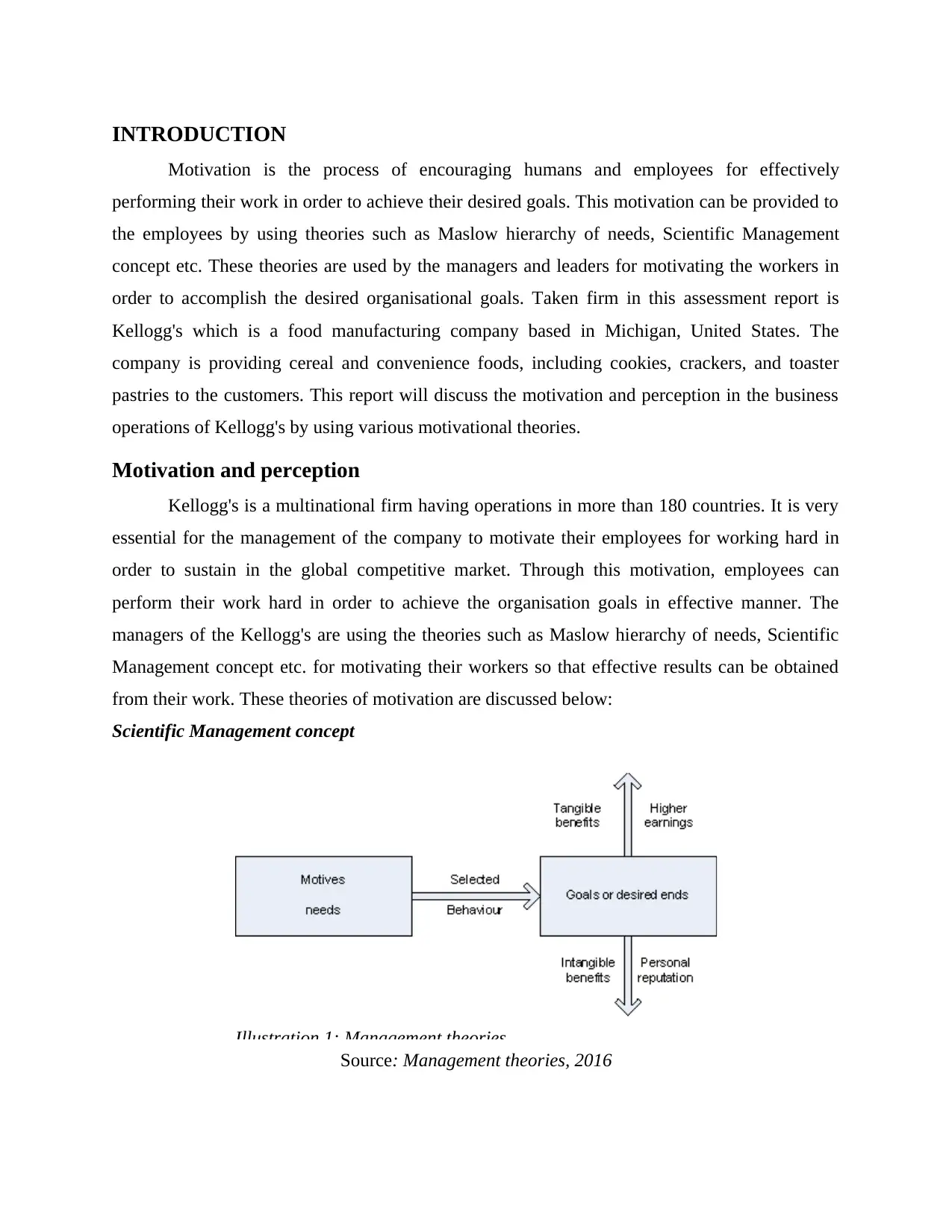
INTRODUCTION
Motivation is the process of encouraging humans and employees for effectively
performing their work in order to achieve their desired goals. This motivation can be provided to
the employees by using theories such as Maslow hierarchy of needs, Scientific Management
concept etc. These theories are used by the managers and leaders for motivating the workers in
order to accomplish the desired organisational goals. Taken firm in this assessment report is
Kellogg's which is a food manufacturing company based in Michigan, United States. The
company is providing cereal and convenience foods, including cookies, crackers, and toaster
pastries to the customers. This report will discuss the motivation and perception in the business
operations of Kellogg's by using various motivational theories.
Motivation and perception
Kellogg's is a multinational firm having operations in more than 180 countries. It is very
essential for the management of the company to motivate their employees for working hard in
order to sustain in the global competitive market. Through this motivation, employees can
perform their work hard in order to achieve the organisation goals in effective manner. The
managers of the Kellogg's are using the theories such as Maslow hierarchy of needs, Scientific
Management concept etc. for motivating their workers so that effective results can be obtained
from their work. These theories of motivation are discussed below:
Scientific Management concept
Source: Management theories, 2016
Illustration 1: Management theories
Motivation is the process of encouraging humans and employees for effectively
performing their work in order to achieve their desired goals. This motivation can be provided to
the employees by using theories such as Maslow hierarchy of needs, Scientific Management
concept etc. These theories are used by the managers and leaders for motivating the workers in
order to accomplish the desired organisational goals. Taken firm in this assessment report is
Kellogg's which is a food manufacturing company based in Michigan, United States. The
company is providing cereal and convenience foods, including cookies, crackers, and toaster
pastries to the customers. This report will discuss the motivation and perception in the business
operations of Kellogg's by using various motivational theories.
Motivation and perception
Kellogg's is a multinational firm having operations in more than 180 countries. It is very
essential for the management of the company to motivate their employees for working hard in
order to sustain in the global competitive market. Through this motivation, employees can
perform their work hard in order to achieve the organisation goals in effective manner. The
managers of the Kellogg's are using the theories such as Maslow hierarchy of needs, Scientific
Management concept etc. for motivating their workers so that effective results can be obtained
from their work. These theories of motivation are discussed below:
Scientific Management concept
Source: Management theories, 2016
Illustration 1: Management theories
⊘ This is a preview!⊘
Do you want full access?
Subscribe today to unlock all pages.

Trusted by 1+ million students worldwide
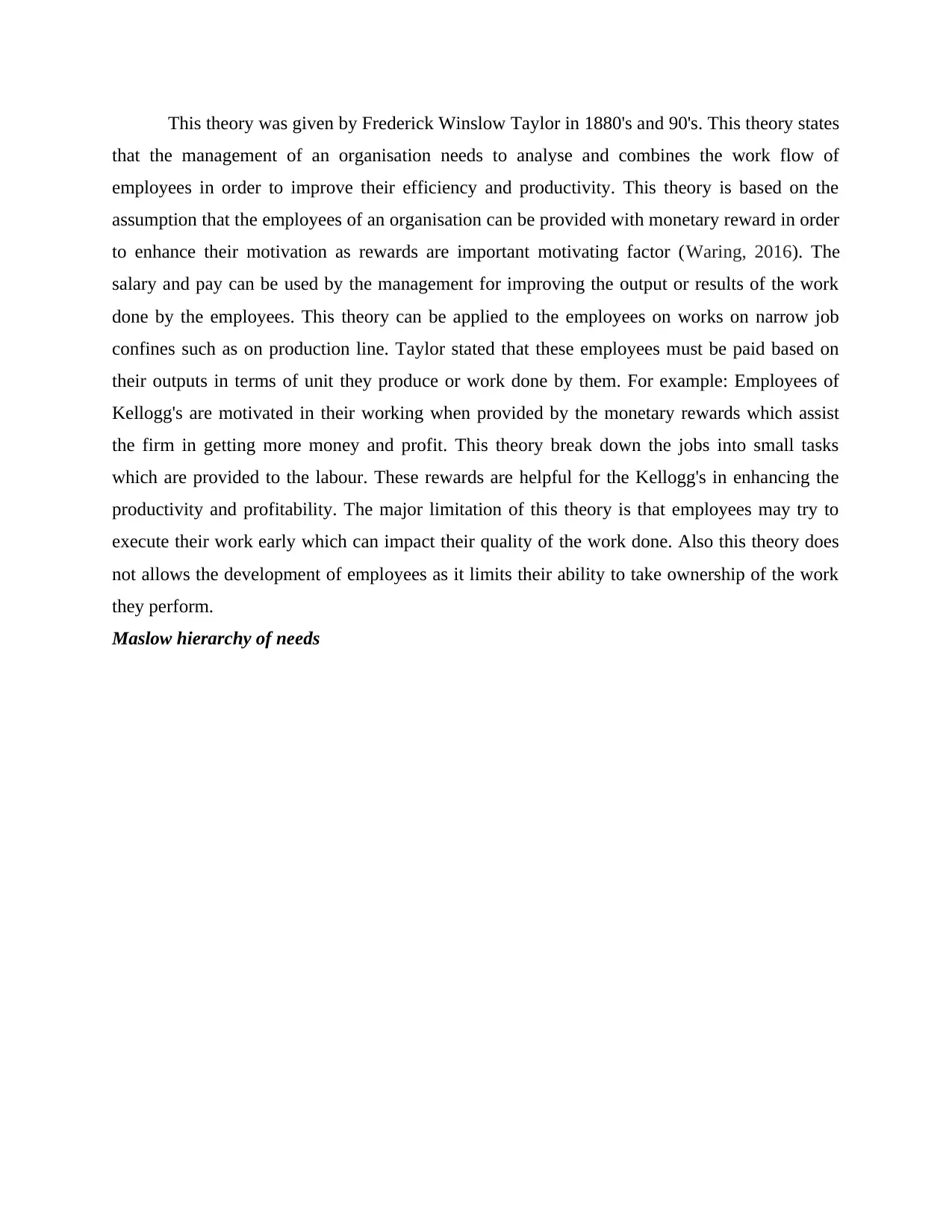
This theory was given by Frederick Winslow Taylor in 1880's and 90's. This theory states
that the management of an organisation needs to analyse and combines the work flow of
employees in order to improve their efficiency and productivity. This theory is based on the
assumption that the employees of an organisation can be provided with monetary reward in order
to enhance their motivation as rewards are important motivating factor (Waring, 2016). The
salary and pay can be used by the management for improving the output or results of the work
done by the employees. This theory can be applied to the employees on works on narrow job
confines such as on production line. Taylor stated that these employees must be paid based on
their outputs in terms of unit they produce or work done by them. For example: Employees of
Kellogg's are motivated in their working when provided by the monetary rewards which assist
the firm in getting more money and profit. This theory break down the jobs into small tasks
which are provided to the labour. These rewards are helpful for the Kellogg's in enhancing the
productivity and profitability. The major limitation of this theory is that employees may try to
execute their work early which can impact their quality of the work done. Also this theory does
not allows the development of employees as it limits their ability to take ownership of the work
they perform.
Maslow hierarchy of needs
that the management of an organisation needs to analyse and combines the work flow of
employees in order to improve their efficiency and productivity. This theory is based on the
assumption that the employees of an organisation can be provided with monetary reward in order
to enhance their motivation as rewards are important motivating factor (Waring, 2016). The
salary and pay can be used by the management for improving the output or results of the work
done by the employees. This theory can be applied to the employees on works on narrow job
confines such as on production line. Taylor stated that these employees must be paid based on
their outputs in terms of unit they produce or work done by them. For example: Employees of
Kellogg's are motivated in their working when provided by the monetary rewards which assist
the firm in getting more money and profit. This theory break down the jobs into small tasks
which are provided to the labour. These rewards are helpful for the Kellogg's in enhancing the
productivity and profitability. The major limitation of this theory is that employees may try to
execute their work early which can impact their quality of the work done. Also this theory does
not allows the development of employees as it limits their ability to take ownership of the work
they perform.
Maslow hierarchy of needs
Paraphrase This Document
Need a fresh take? Get an instant paraphrase of this document with our AI Paraphraser
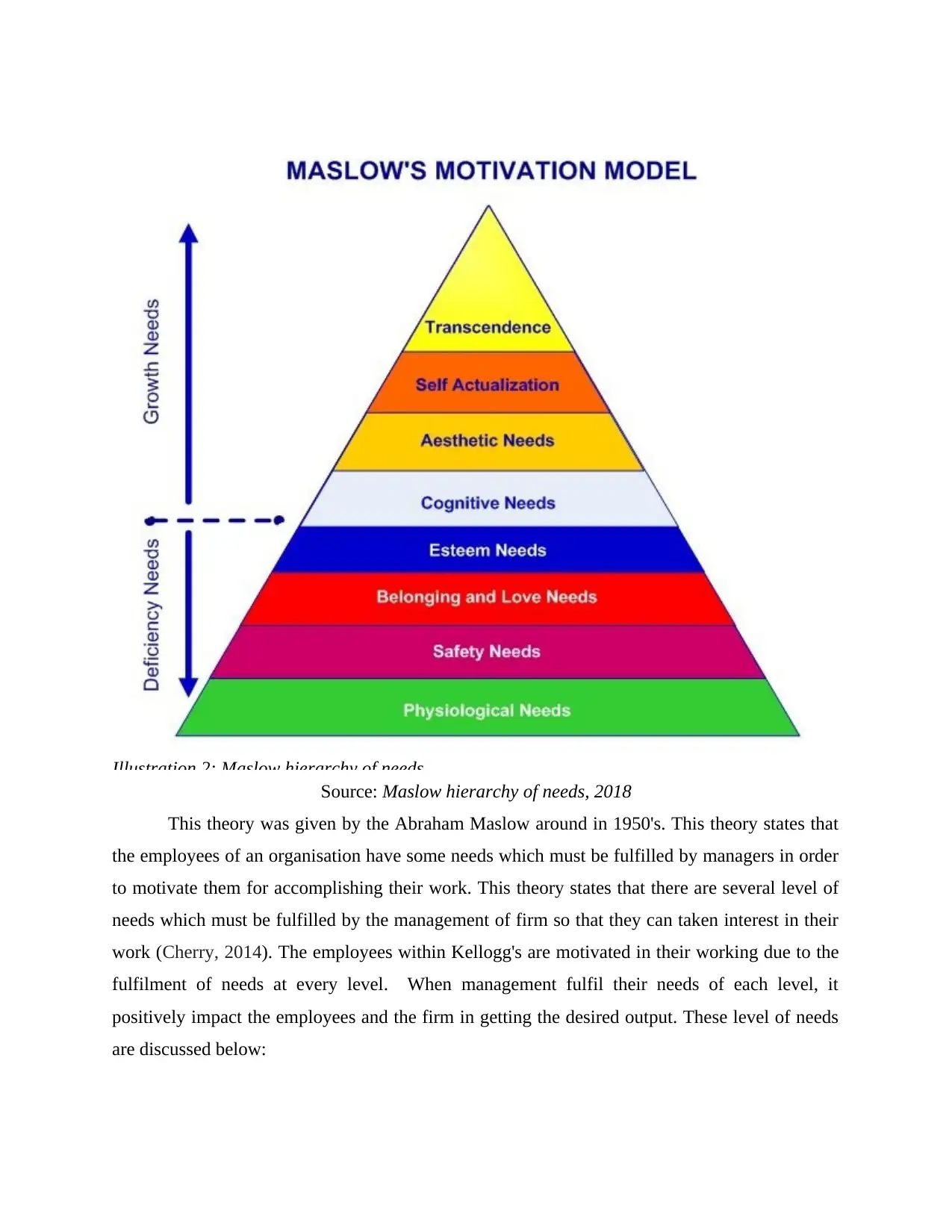
Illustration 2: Maslow hierarchy of needs
Source: Maslow hierarchy of needs, 2018
This theory was given by the Abraham Maslow around in 1950's. This theory states that
the employees of an organisation have some needs which must be fulfilled by managers in order
to motivate them for accomplishing their work. This theory states that there are several level of
needs which must be fulfilled by the management of firm so that they can taken interest in their
work (Cherry, 2014). The employees within Kellogg's are motivated in their working due to the
fulfilment of needs at every level. When management fulfil their needs of each level, it
positively impact the employees and the firm in getting the desired output. These level of needs
are discussed below:
Source: Maslow hierarchy of needs, 2018
This theory was given by the Abraham Maslow around in 1950's. This theory states that
the employees of an organisation have some needs which must be fulfilled by managers in order
to motivate them for accomplishing their work. This theory states that there are several level of
needs which must be fulfilled by the management of firm so that they can taken interest in their
work (Cherry, 2014). The employees within Kellogg's are motivated in their working due to the
fulfilment of needs at every level. When management fulfil their needs of each level, it
positively impact the employees and the firm in getting the desired output. These level of needs
are discussed below:
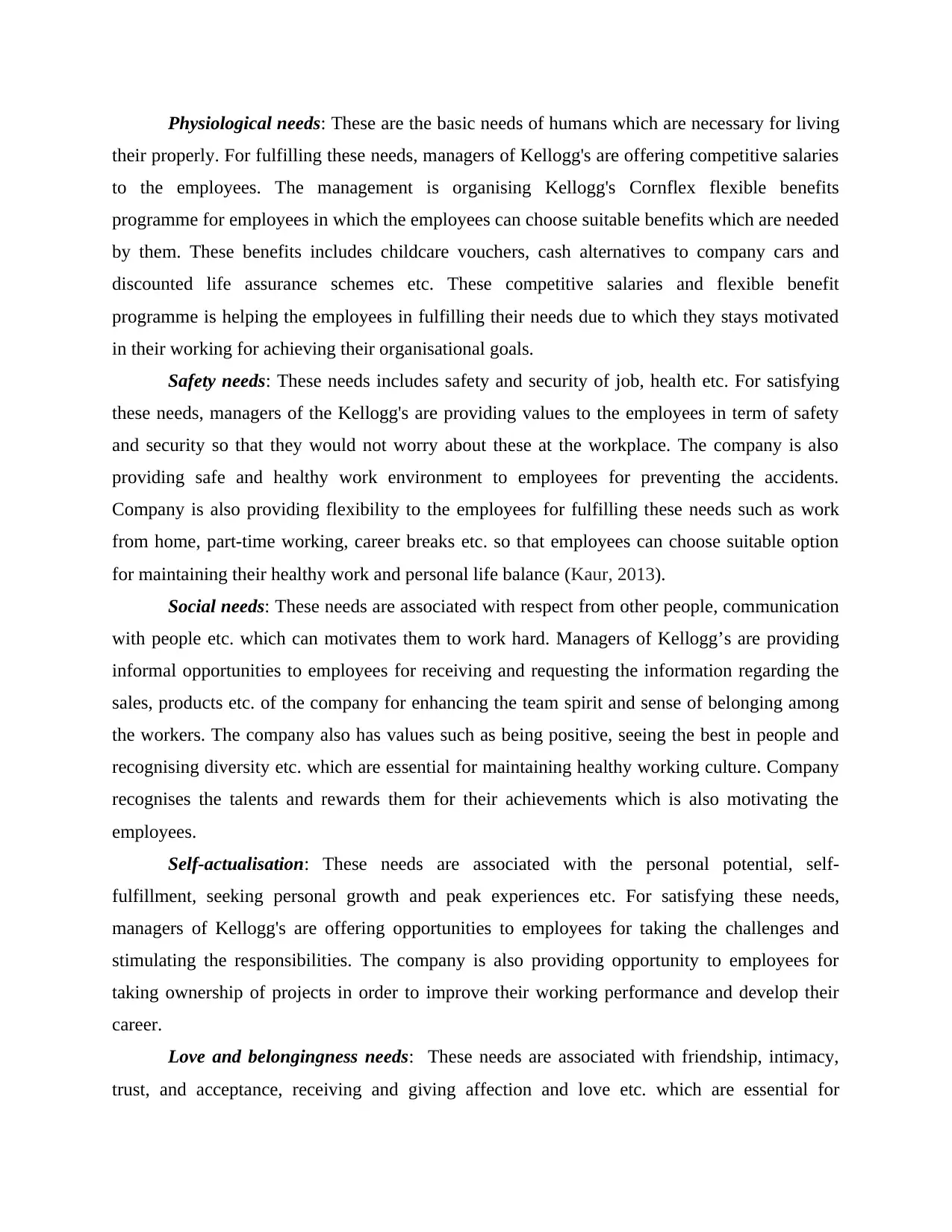
Physiological needs: These are the basic needs of humans which are necessary for living
their properly. For fulfilling these needs, managers of Kellogg's are offering competitive salaries
to the employees. The management is organising Kellogg's Cornflex flexible benefits
programme for employees in which the employees can choose suitable benefits which are needed
by them. These benefits includes childcare vouchers, cash alternatives to company cars and
discounted life assurance schemes etc. These competitive salaries and flexible benefit
programme is helping the employees in fulfilling their needs due to which they stays motivated
in their working for achieving their organisational goals.
Safety needs: These needs includes safety and security of job, health etc. For satisfying
these needs, managers of the Kellogg's are providing values to the employees in term of safety
and security so that they would not worry about these at the workplace. The company is also
providing safe and healthy work environment to employees for preventing the accidents.
Company is also providing flexibility to the employees for fulfilling these needs such as work
from home, part-time working, career breaks etc. so that employees can choose suitable option
for maintaining their healthy work and personal life balance (Kaur, 2013).
Social needs: These needs are associated with respect from other people, communication
with people etc. which can motivates them to work hard. Managers of Kellogg’s are providing
informal opportunities to employees for receiving and requesting the information regarding the
sales, products etc. of the company for enhancing the team spirit and sense of belonging among
the workers. The company also has values such as being positive, seeing the best in people and
recognising diversity etc. which are essential for maintaining healthy working culture. Company
recognises the talents and rewards them for their achievements which is also motivating the
employees.
Self-actualisation: These needs are associated with the personal potential, self-
fulfillment, seeking personal growth and peak experiences etc. For satisfying these needs,
managers of Kellogg's are offering opportunities to employees for taking the challenges and
stimulating the responsibilities. The company is also providing opportunity to employees for
taking ownership of projects in order to improve their working performance and develop their
career.
Love and belongingness needs: These needs are associated with friendship, intimacy,
trust, and acceptance, receiving and giving affection and love etc. which are essential for
their properly. For fulfilling these needs, managers of Kellogg's are offering competitive salaries
to the employees. The management is organising Kellogg's Cornflex flexible benefits
programme for employees in which the employees can choose suitable benefits which are needed
by them. These benefits includes childcare vouchers, cash alternatives to company cars and
discounted life assurance schemes etc. These competitive salaries and flexible benefit
programme is helping the employees in fulfilling their needs due to which they stays motivated
in their working for achieving their organisational goals.
Safety needs: These needs includes safety and security of job, health etc. For satisfying
these needs, managers of the Kellogg's are providing values to the employees in term of safety
and security so that they would not worry about these at the workplace. The company is also
providing safe and healthy work environment to employees for preventing the accidents.
Company is also providing flexibility to the employees for fulfilling these needs such as work
from home, part-time working, career breaks etc. so that employees can choose suitable option
for maintaining their healthy work and personal life balance (Kaur, 2013).
Social needs: These needs are associated with respect from other people, communication
with people etc. which can motivates them to work hard. Managers of Kellogg’s are providing
informal opportunities to employees for receiving and requesting the information regarding the
sales, products etc. of the company for enhancing the team spirit and sense of belonging among
the workers. The company also has values such as being positive, seeing the best in people and
recognising diversity etc. which are essential for maintaining healthy working culture. Company
recognises the talents and rewards them for their achievements which is also motivating the
employees.
Self-actualisation: These needs are associated with the personal potential, self-
fulfillment, seeking personal growth and peak experiences etc. For satisfying these needs,
managers of Kellogg's are offering opportunities to employees for taking the challenges and
stimulating the responsibilities. The company is also providing opportunity to employees for
taking ownership of projects in order to improve their working performance and develop their
career.
Love and belongingness needs: These needs are associated with friendship, intimacy,
trust, and acceptance, receiving and giving affection and love etc. which are essential for
⊘ This is a preview!⊘
Do you want full access?
Subscribe today to unlock all pages.

Trusted by 1+ million students worldwide
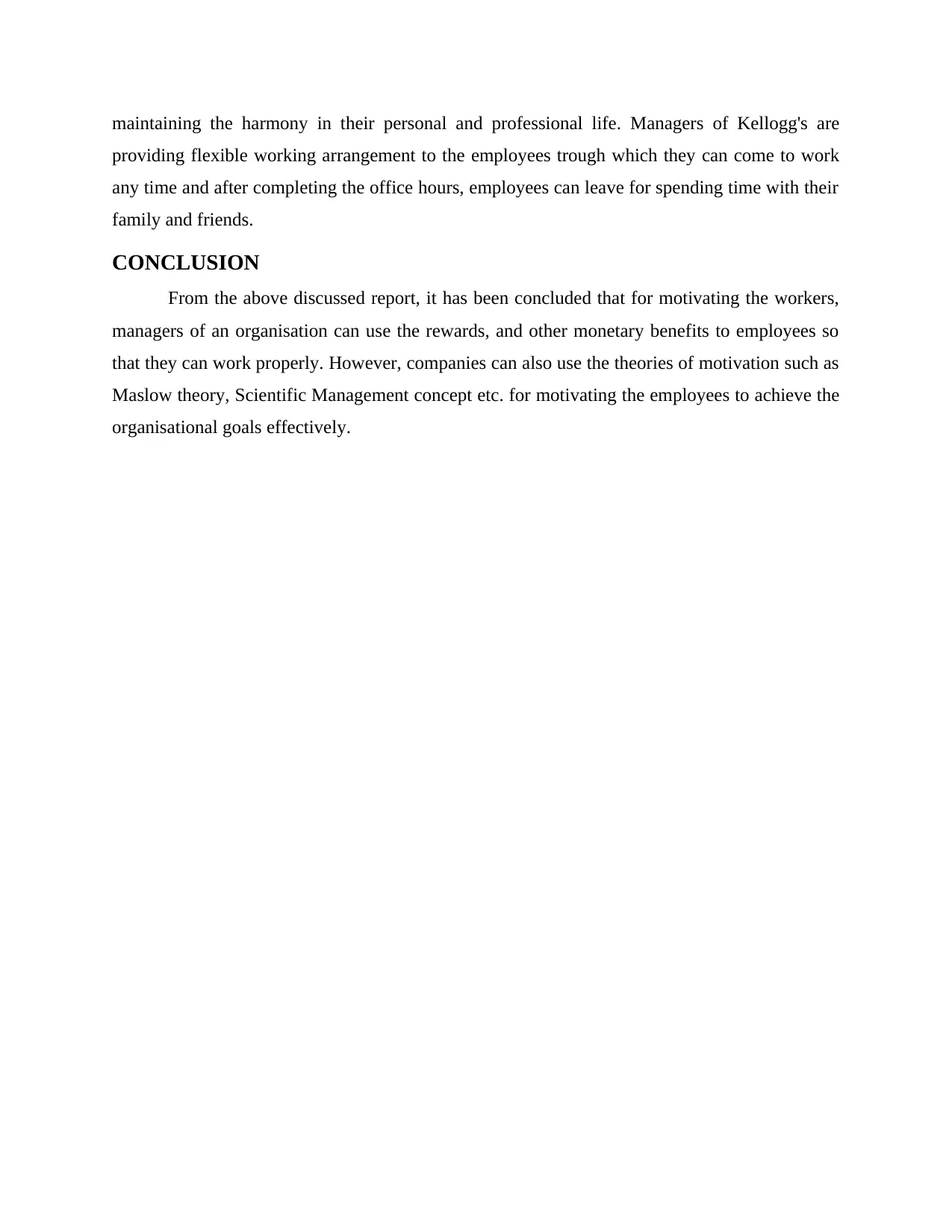
maintaining the harmony in their personal and professional life. Managers of Kellogg's are
providing flexible working arrangement to the employees trough which they can come to work
any time and after completing the office hours, employees can leave for spending time with their
family and friends.
CONCLUSION
From the above discussed report, it has been concluded that for motivating the workers,
managers of an organisation can use the rewards, and other monetary benefits to employees so
that they can work properly. However, companies can also use the theories of motivation such as
Maslow theory, Scientific Management concept etc. for motivating the employees to achieve the
organisational goals effectively.
providing flexible working arrangement to the employees trough which they can come to work
any time and after completing the office hours, employees can leave for spending time with their
family and friends.
CONCLUSION
From the above discussed report, it has been concluded that for motivating the workers,
managers of an organisation can use the rewards, and other monetary benefits to employees so
that they can work properly. However, companies can also use the theories of motivation such as
Maslow theory, Scientific Management concept etc. for motivating the employees to achieve the
organisational goals effectively.
Paraphrase This Document
Need a fresh take? Get an instant paraphrase of this document with our AI Paraphraser
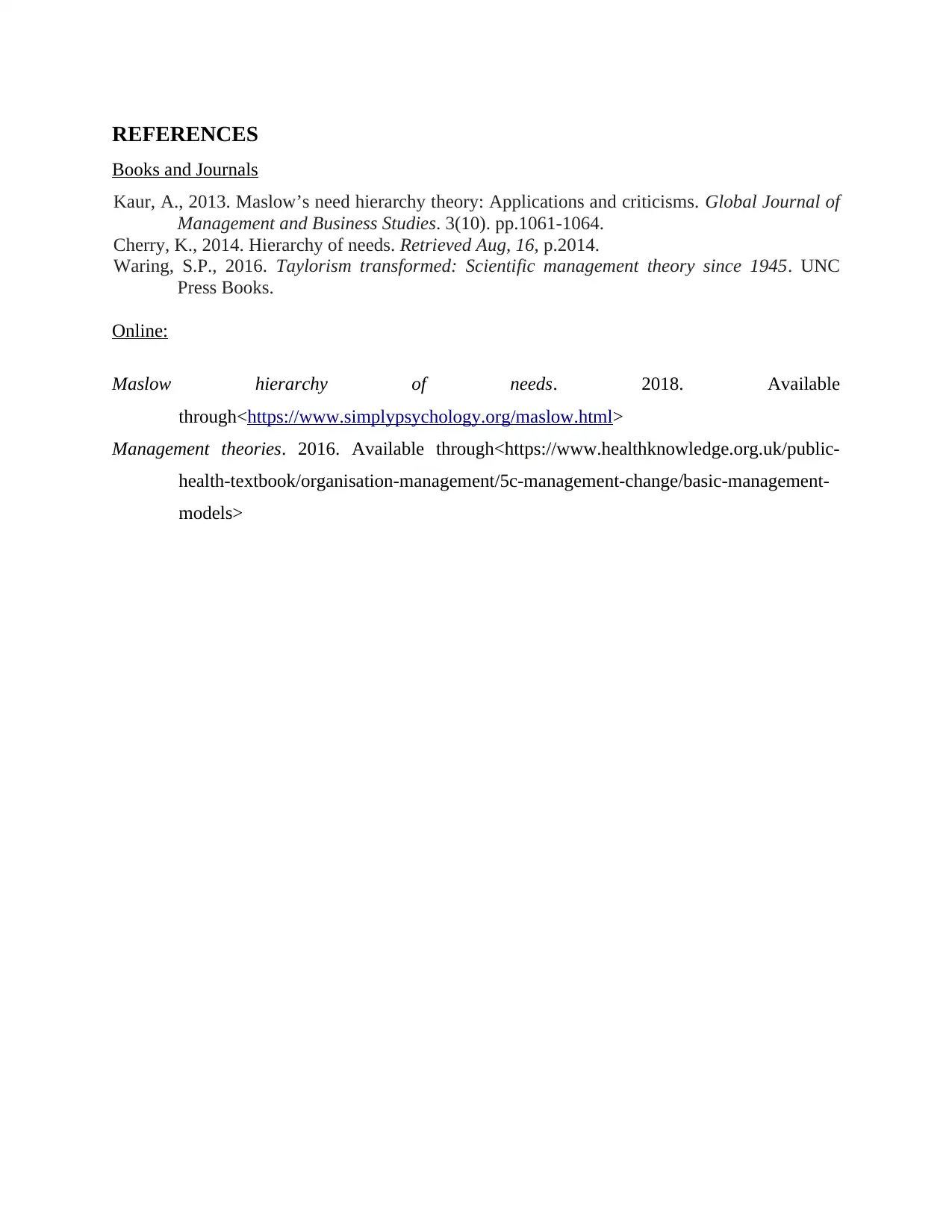
REFERENCES
Books and Journals
Kaur, A., 2013. Maslow’s need hierarchy theory: Applications and criticisms. Global Journal of
Management and Business Studies. 3(10). pp.1061-1064.
Cherry, K., 2014. Hierarchy of needs. Retrieved Aug, 16, p.2014.
Waring, S.P., 2016. Taylorism transformed: Scientific management theory since 1945. UNC
Press Books.
Online:
Maslow hierarchy of needs. 2018. Available
through<https://www.simplypsychology.org/maslow.html>
Management theories. 2016. Available through<https://www.healthknowledge.org.uk/public-
health-textbook/organisation-management/5c-management-change/basic-management-
models>
Books and Journals
Kaur, A., 2013. Maslow’s need hierarchy theory: Applications and criticisms. Global Journal of
Management and Business Studies. 3(10). pp.1061-1064.
Cherry, K., 2014. Hierarchy of needs. Retrieved Aug, 16, p.2014.
Waring, S.P., 2016. Taylorism transformed: Scientific management theory since 1945. UNC
Press Books.
Online:
Maslow hierarchy of needs. 2018. Available
through<https://www.simplypsychology.org/maslow.html>
Management theories. 2016. Available through<https://www.healthknowledge.org.uk/public-
health-textbook/organisation-management/5c-management-change/basic-management-
models>
1 out of 8
Related Documents
Your All-in-One AI-Powered Toolkit for Academic Success.
+13062052269
info@desklib.com
Available 24*7 on WhatsApp / Email
![[object Object]](/_next/static/media/star-bottom.7253800d.svg)
Unlock your academic potential
Copyright © 2020–2025 A2Z Services. All Rights Reserved. Developed and managed by ZUCOL.



